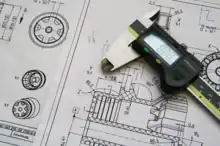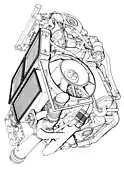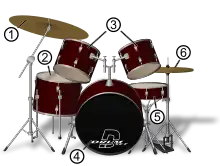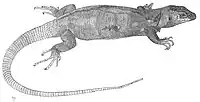Technical illustration
Technical Illustration is illustration meant to visually communicate information of a technical nature. Technical illustrations can be components of technical drawings or diagrams. Technical illustrations in general aim "to generate expressive images that effectively convey certain information via the visual channel to the human observer".[1]

| Part of series on |
| Technical drawings |
|---|
 |
Technical illustrations generally have to describe and explain the subjects to a nontechnical audience. Therefore, the visual image should be accurate in terms of dimensions and proportions, and should provide "an overall impression of what an object is or does, to enhance the viewer’s interest and understanding".[2]
Types
Types of communication
Today, technical illustration can be broken down into three categories based on the type of communication:
- Communication with the general public: informs the general public, for example illustrated instructions found in the manuals for automobiles and consumer electronics. This type of technical illustration contains simple terminology and symbols that can be understood by the lay person and is sometimes called creative technical illustration/graphics.
- Specialized engineering or scientific communication: used by engineers/scientists to communicate with their peers and in specifications. This use of technical illustration has its own complex terminology and specialized symbols; examples are the fields of atomic energy, aerospace and military/defense. These areas can be further broken down into disciplines of mechanical, electrical, architectural engineering and many more.
- Communication between highly skilled experts: used by engineers to communicate with people who are highly skilled in a field, but who are not engineers. Examples of this type of technical illustration are illustrations found in user/operator documentation. These illustrations can be very complex and have jargon and symbols not understood by the general public, such as illustrations that are part of instructional materials for operating CNC machinery.
Types of drawings
Main types of drawings in technical communication are:[3]
- conventional line drawings,
- exploded view drawings,
- cutaway drawings, and
- clip art images
Techniques

Technical illustration uses several basic mechanical drawing configurations called axonometric projection. These are:
- Parallel projections (oblique, planometric, isometric, dimetric, and trimetric), and
- many types of perspective projections (with one, two, or three vanishing points).
Technical illustration and computer-aided design can also use 3D and solid-body projections, such as rapid prototyping.
- In the natural sciences, "scientific illustration" refers to a style of drawing using stippling and simple line techniques to convey information with a minimum of artistic interpretation.
Examples
 Small kitchen in perspective
Small kitchen in perspective Conventional line illustration of an engine demonstrating perspective and line techniques.
Conventional line illustration of an engine demonstrating perspective and line techniques. Illustration of a drum set.
Illustration of a drum set. Gallotia simonyi, example of pen and ink scientific illustration
Gallotia simonyi, example of pen and ink scientific illustration_RMG_J6458.jpg.webp) Broken view plan, showing the decks of a ship, drawn 1783
Broken view plan, showing the decks of a ship, drawn 1783
Further reading
- McDonnell, Phyllis Wood. With a chapter by Patrick (1994). Scientific illustration : a guide to biological, zoological, and medical rendering techniques, design, printing, and display (2. ed.). New York, NY [u.a.]: Wiley. ISBN 978-0471285250.
See also
References
- Ivan Viola and Meister E. Gröller (2005). "Smart Visibility in Visualization". In: Computational Aesthetics in Graphics, Visualization and Imaging. L. Neumann et al. (Ed.)
- Devis, Mae (14 May 2011). "משרביות". www.laser-group.co.il. Retrieved 14 June 2016.
- Oliu, Gerald J. Alred, Charles T. Brusaw, Walter E. (2012). The business writer's handbook (10th ed.). Boston: Bedford/St. Martins. p. 172. ISBN 978-0312679439. Retrieved 14 June 2016.
{{cite book}}: CS1 maint: multiple names: authors list (link)
External links
- Technical Illustration – A Historical Perspective by Kevin Hulsey
- Technical Illustration in the 21st Century: A Primer for Today’s Professionals by Parametric Technology Corporation (PTC) 2007. (requires login)
- Stuttgart Database of Scientific Illustrators 1450–1950 (DSI) (with more than 6000 entries and 20 search fields)